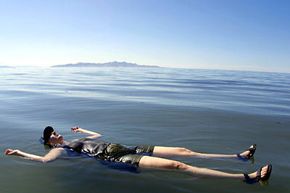Human Salt Consumption
The sodium and chlorine in salt are electrolytes, minerals that conduct electricity in our fluids and tissues. The other main electrolytes are potassium, calcium and magnesium. Our kidneys maintain the balance of electrolytes and water by regulating the fluids that we take in and pass out of our bodies. If this balance is disturbed, our muscles, nerves and organs won't function correctly because the cells can't generate muscle contractions and nerve impulses.
Too little salt, or hyponatremia, is one of the most common electrolyte disturbances. You can lose sodium when you sweat or urinate excessively, experience severe vomiting or diarrhea, or when you drink a lot of water (which is why sports drinks contain electrolytes). Taking diuretics, which make the body excrete excess water, can also cause you to lose too much sodium. Ultimately, hyponatremia can lead to brain swelling and death. If you have very strong cravings for salt, you may be dehydrated or lacking one of the minerals in table salt. But an extreme salt craving can be a symptom of Addison's disease (a hormonal disorder) or Barrter's syndrome (a rare kidney disorder).
Advertisement
If you have too much sodium in your body, you might get very thirsty and urinate more to get rid of the excess. You probably hear about too much sodium, or hypernatremia, much more often than you hear about hyponatremia. But sometimes your kidneys can't eliminate all of the excess. When this happens, your blood volume can increase (because sodium holds in water), which in turn can make your heart pump harder. Because of this, some doctors have treated chronic fatigue syndrome by increasing the patient's sodium intake.
The National Heart, Blood and Lung Institute recommends that most people consume no more than 2.4 grams of sodium (the equivalent of about one teaspoon) per day [source: NHBLI]. We probably don't need more than half a gram per day to maintain the proper electrolyte balance [source: New York Times]. Many people eat several times that much.
Excess salt intake has been linked to many different medical conditions, but the links are often controversial. For example, many doctors and researchers claim that a low-sodium diet can help regulate blood pressure (because excess sodium can increase blood pressure). But others believe that reduced sodium doesn't have a significant effect on blood pressure. Too much salt has also been thought to cause heartburn and increase the risk of osteoporosis, ulcers and gastric cancer, but these links are somewhat controversial as well.
Regardless of the latest medical advice about salt intake, it's probably a good idea to pay attention to how much salt you're eating. Fast food and prepackaged convenience foods (like frozen dinners or canned soup) have a lot of sodium because salt helps preserve food by drawing out moisture and keeping out bacteria. So, if you eat a lot of fast food, you may be eating more salt than you think. But what type of salt is it? In the next section, we'll learn about the many different kinds of salt.
